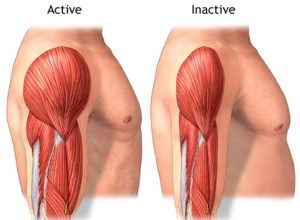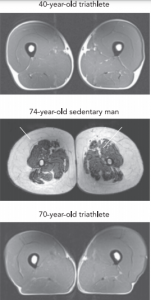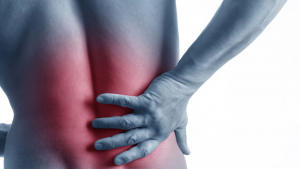
As we age, it’s natural that we start to lose muscle mass. The scientific term for this is sarcopenia, which refers to the loss of skeletal muscle mass and strength in an individual who is aging. This progressive reduction in lean muscle leads to decreases in mobility and independence, as well as, increasing the individual’s risk for other health conditions. The effects of sarcopenia are more evident in those who are aged 30+ with some studies showing 3-5% of muscle loss per year. But luckily, it is possible to regain lost muscle mass!
WHAT CAN YOU DO?
Although all kinds of physical activity is beneficial, it is specifically resistance and strength training that can increase muscle mass.
WHAT ARE SOME OTHER WAYS TO PREVENT SARCOPENIA?
Other proven methods that we can use to slow the rate of muscle degradation would be to increase our total amount of protein intake. For  those instances where it may be challenging to reach our protein intake goals, we can choose to use protein supplements. In collaboration with increasing our protein consumption, we can consume leaner sources of protein like chicken, fish, and beans rather than fattier sources like beef. Lastly, it has been shown that a 30% reduction in calories consumed is directly related to decreased inflammation, increased production of antioxidants and a younger looking appearance. Incorporating some of these strategies will help to attenuate the effects of aging by increasing the rate of protein synthesis, therefore assisting in the retention of muscle mass. (link to article here)
those instances where it may be challenging to reach our protein intake goals, we can choose to use protein supplements. In collaboration with increasing our protein consumption, we can consume leaner sources of protein like chicken, fish, and beans rather than fattier sources like beef. Lastly, it has been shown that a 30% reduction in calories consumed is directly related to decreased inflammation, increased production of antioxidants and a younger looking appearance. Incorporating some of these strategies will help to attenuate the effects of aging by increasing the rate of protein synthesis, therefore assisting in the retention of muscle mass. (link to article here)
WHY SHOULD YOU CARE?
First of all, let us take a look at a 2016 article called Physical Activity, Aging, and Physiological Function. It examines the correlation between aging & exercise and the effects it has on the body. Based on the evolution of the human body, it suggests that our bodies are meant to stay physically active. Thus, there are serious negative effects to the body when kept inactive or sedentary. (link to the article here)

Here is a diagram that portrays the two extremes of the spectrum of being physically active and sedentary. It depicts a cross-sectional MRI scan of three individuals’ thighs. The individuals involved in the study were a 40 year old triathlete, 74 year old sedentary man, and a 70 year old triathlete. The 40 and 70 year old triathletes had more lean muscle mass (shown in grey) compared to the 74 year old sedentary man who had more adipose or fat tissue (white). Not only does he have a greater volume of adipose, the sedentary individual’s MRI scan also showed some of the adipose tissue was situated within the lean muscle tissue. Cases of fat infiltration within the muscle is correlated to poor knee extensor strength, decreased muscle fiber recruitment and decreased in muscle contractility. At a higher age, there isn’t a lot that can be done to regain or rebuild healthy muscle mass.
Therefore, it is important to maintain a healthy amount of lean muscle mass throughout your life.
HOW CAN WE HELP?
For those that are just beginning to get into exercising, there are 7 foundational movements that form a groundwork for other exercises. These movements include:
1. Squat
2. Hinge
3. Lunge
4. Pull
5. Push
6. Carry
7. Twist


